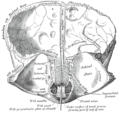Anatomy
The falx cerebri is a strong, crescent-shaped sheet of dura mater lying in the sagittal plane between the two cerebral hemispheres. [3] It is one of four dural partitions of the brain along with the falx cerebelli, tentorium cerebelli, and diaphragma sellae; it is formed through invagination of the dura mater into the longitudinal fissure between the cerebral hemispheres. [2]
Anteriorly, the falx cerebri is narrower, thinner, and may have a number of perforations. It is broader posteriorly. [3]
Attachments
The falx cerebri attaches anteriorly at the crista galli (proximally to the cribriform plate and to the frontal and ethmoid sinuses). [1]
Posteriorly, it blends into the upper surface of the cerebellar tentorium. [3]
Its convex superior margin is attached to the internal surface of the skull on either side of the midline. This attachment runs as far back as the internal occipital protuberance (the latter representing its posterior-most point of attachment [2] ); the superior sagittal sinus runs in the cranial groove between the falx cerebri's two attachments. [3]
The (concave) inferior margin of the falx cerebri is free. [3]
Vascular supply
The falx cerebri receives its blood supply primarily from two vessels; the anterior portion receives blood supply from the anterior meningeal artery (a.k.a. anterior falx artery, or anterior falcine artery) (a branch of the anterior ethmoidal artery), and the posterior portion from the posterior meningeal artery (a branch of the ascending pharyngeal artery). [2]
Lymphatic drainage of the falx cerebri occurs mostly via meningeal lymphatic vessels that run parallel to the dural sinuses and that eventually exit the cranial vault through the jugular foramen to empty into deep cervical lymph nodes. A minority of lymph from the falx cerebri is drained anteriorly through the cribiform plate into the lymphatics of the nasal mucosa. [2]
Innervation
The falx cerebri receives innervation from all three branches of the trigeminal nerve. It receives sympathetic innervation predominantly from the superior cervical ganglia. It may receive additional innervation from dorsal rami of CN 1 and CN 2, the hypoglossal nerve, and recurrent branches of the vagus nerve. [2]
Anatomical relations
The falx cerebri is situated in the longitudinal fissure, in between the cerebral hemispheres. [3] The corpus callosum lies immediately inferior to the lower (free) margin of falx cerebri. [2]
Anatomical variation
Total or partial agenesis of the falx cerebri may occur, and may result in adherence of the cerebral hemispheres across the midline. Agenesis is usually associated with other developmental complications; falx cerebri agenesis in absence of other neural symptoms is exceedingly rare. [2]
Clinical significance
Calcification
Calcification of the falx cerebri is more prevalent in older patients, often without a determinable cause, and without pathogenic symptoms. [5]
Meningioma
Falcine meningioma is a meningioma arising from the falx cerebri and completely concealed by the overlying cortex. Falcine meningioma tends to grow predominantly into one cerebral hemisphere but is often bilateral, and in some patients the tumor grows into the inferior edge of the sagittal sinus. However, although much information is available regarding meningiomas, little is known about falcine meningiomas. [6]
Surgical landmark
The falx cerebri is a significant surgical landmark for access of the lateral ventricles via the interhemispheric transcallosal approach; agenesis (complete or partial) of the falx cerebri results in the adherence of the cerebral hemispheres, blocking midline transcallosal surgical access to the ventricles. [2]
This page is based on this
Wikipedia article Text is available under the
CC BY-SA 4.0 license; additional terms may apply.
Images, videos and audio are available under their respective licenses.






